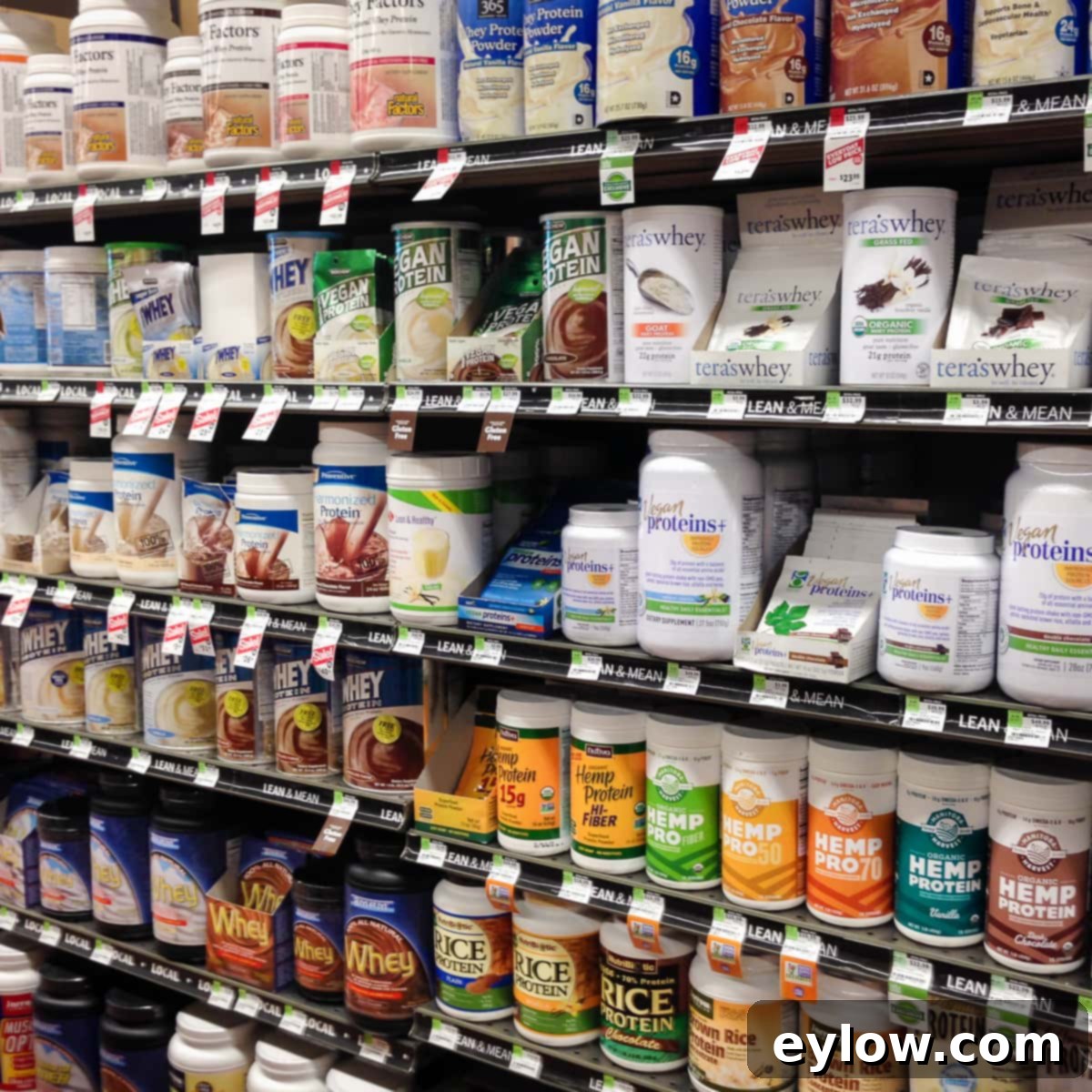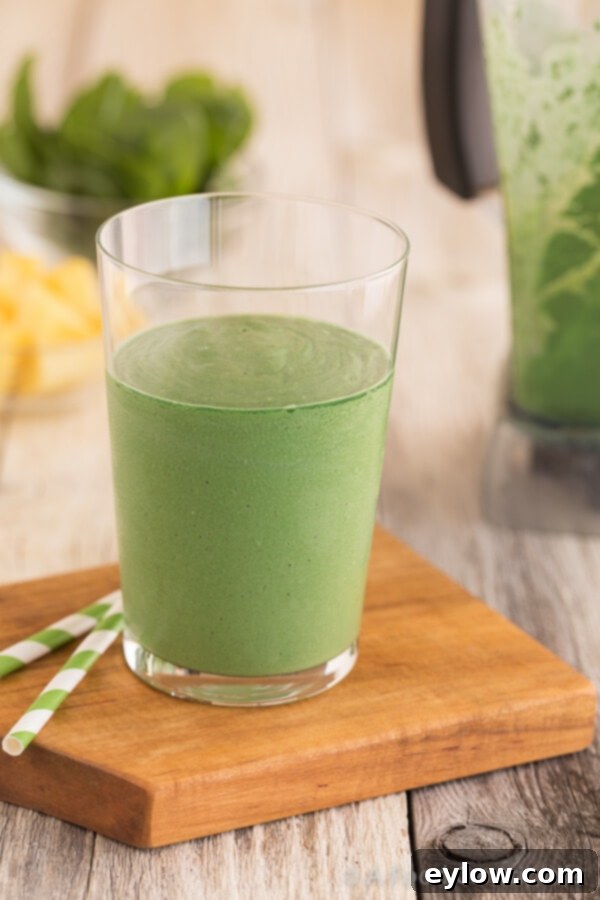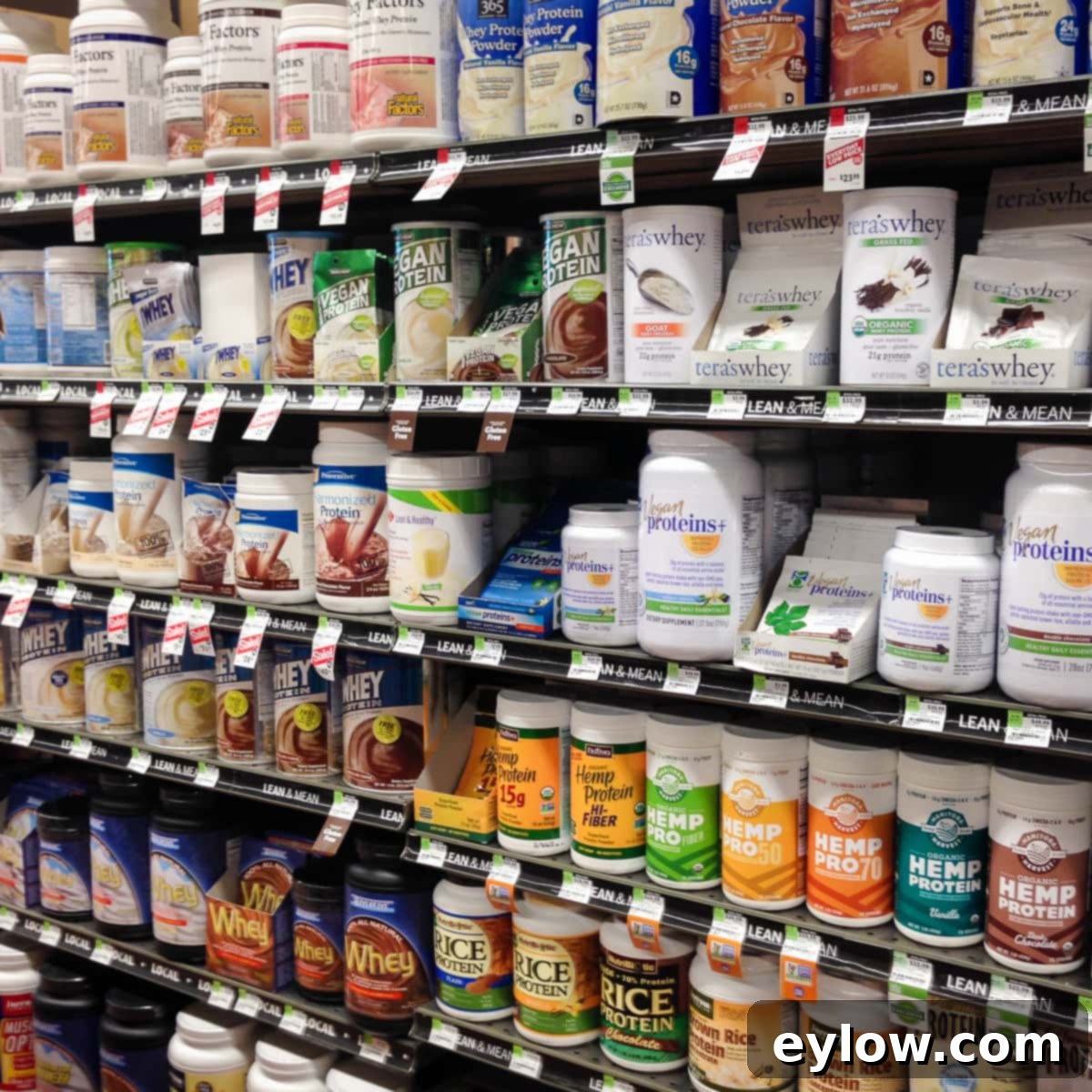The Ultimate Guide to Choosing the Best Protein Powder for Your Health and Fitness Goals
In today’s fast-paced world, finding convenient yet nutritious ways to fuel your body is essential. Smoothies, especially those fortified with protein powder, have become a go-to solution for many looking for an energizing start to their day or a quick, healthy snack. However, the sheer volume of protein powder options on the market can be overwhelming. This comprehensive guide will walk you through everything you need to know about selecting the right protein powder, ensuring you make an informed choice that aligns with your dietary needs and health aspirations.

Protein powders serve as an incredibly efficient way to supplement high-quality protein into your daily diet. What was once exclusively the domain of bodybuilders and elite athletes has now expanded to a wide range of health-conscious individuals. With an ever-growing variety of options, there’s a protein powder designed to fit nearly every personal preference and dietary requirement.
A common concern surrounding protein powders is the extent of their processing. While it’s true that some products historically contained excessive additives, the industry has evolved significantly. Today, the market offers a wealth of “clean” and high-quality protein powder options that prioritize natural ingredients and minimal processing.
Despite these advancements, it’s crucial to remain vigilant. Unfortunately, low-quality products still exist, often loaded with undesirable additives. These can include artificial sweeteners and flavors, genetically modified (GM) or engineered ingredients, preservatives, and even contaminants like heavy metals, as highlighted by reputable consumer reports. Therefore, a diligent approach to reading labels is not just recommended, but absolutely critical to ensure you’re consuming a product that genuinely supports your health goals rather than undermining them.
Why Incorporate Protein Powder into Your Diet?
Protein plays a vital role in satiety, energy balance, and reducing cravings throughout the day. Integrating a good source of protein into your breakfast, and indeed all meals, can significantly impact how you feel. When you add protein powder to a morning smoothie, it helps you feel fuller and more satisfied for longer periods, preventing mid-morning energy crashes and unhealthy snacking. Beyond its nutritional benefits, a protein-packed smoothie can be prepared in mere minutes, making it an ideal solution for busy mornings or as a convenient meal on the go, whether you’re heading to work or school.
But protein powder isn’t just for smoothies! Its versatility extends to various recipes, enhancing the protein content of everything from baked goods to savory dishes. For instance, you can try incorporating it into no-bake energy bites, muffins, oatmeal, or even soups to boost your protein intake in creative and delicious ways.
Understanding Protein Concentrates vs. Isolates
When exploring protein powders, you’ll frequently encounter the terms “concentrate” and “isolate.” Understanding the distinction between these two forms is key to choosing the right product for your needs.
Protein Concentrates generally undergo less processing. They typically contain a lower percentage of protein per serving (ranging from 70-80%) and retain more of the natural fats, carbohydrates (including lactose in dairy-based proteins), and beneficial compounds found in the original source. Due to less extensive processing, concentrates are often more affordable and may be favored by those seeking a less refined product.
Protein Isolates, on the other hand, undergo more rigorous processing to remove most of the fat and lactose, resulting in a higher protein content per serving, often 90% or more. This makes isolates a preferred choice for individuals who are lactose sensitive, or those aiming to maximize their protein intake while minimizing calories from fats and carbs. While isolates offer a purer protein profile, their increased processing can sometimes lead to a slightly higher price point. When evaluating concentrates versus isolates, it’s essential to scrutinize labels and, if necessary, delve into the producers’ websites or even contact them directly for detailed information on their processing methods and ingredient sourcing.
Exploring Animal-Based Protein Options
Animal-based protein powders are derived from dairy, eggs, or collagen sources, each offering distinct benefits and considerations.
Whey Protein
Whey is one of the most popular protein powders, derived from milk and known for its excellent amino acid profile and rapid absorption. It’s available from both cow and goat milk. For those who experience digestive discomfort with cow’s milk, goat milk whey might be a more digestible alternative due to its smaller fat particles. If lactose intolerance is a concern, look specifically for “lactose-free” whey options.
For optimal quality, choose organic, grass-fed, and hormone-free whey protein powders. “Grass-fed” indicates that the cows primarily grazed on pasture, often resulting in a product with a better fatty acid profile. Ensure the label explicitly states “rBGH-free” (no artificial growth hormones) and “non-GMO.” While organic standards are good, “grass-fed” often goes beyond basic organic requirements, especially regarding animal feed. Additionally, prioritize brands that use cold processing methods to ensure the protein remains un-denatured, preserving its natural structure and bioavailability. Heat processing can denature proteins, potentially reducing their effectiveness.
Whey proteins typically offer a higher gram count of protein per serving, mix easily, and create creamier textures in smoothies compared to many plant-based options. They provide a complete amino acid profile, supplying all essential amino acids necessary for muscle repair and growth. However, individual processing methods vary between brands, and importantly, many people have sensitivities to dairy or choose to avoid it for ethical or dietary reasons.
Casein Protein
Casein is another prominent protein found in dairy milk, but unlike whey, it digests and absorbs very slowly. This slow-release property makes casein an excellent choice for sustained amino acid delivery, particularly beneficial before bed or during long periods without food, supporting muscle recovery and preventing muscle breakdown. While highly effective, individuals with significant lactose sensitivities might find casein harder to digest than lactose-free whey isolates. Further insights into casein protein and its benefits can be found in helpful resources like this article about casein protein.
Egg White Protein
If you’re looking to avoid dairy altogether, egg white protein powder is a fantastic alternative. It’s a complete protein, rich in essential amino acids, and typically very easy to digest. However, it’s crucial to check the sodium levels on the nutrition label, as some brands can contain surprisingly high amounts. For a high-quality, dairy-free option, an egg white-based protein powder such as the one used here comes highly recommended.
Collagen Protein
Collagen is the most abundant protein in our bodies, forming the structural framework of bones, muscles, blood vessels, skin, and connective tissues. Its presence is why a good bone broth has a gelatinous, jiggly consistency. Our natural collagen production declines with age and can be negatively impacted by lifestyle factors like excessive sugar intake, smoking, and sun exposure. Supplementing with collagen can offer numerous benefits, including strengthening hair, nails, and bones, improving skin elasticity, supporting joint health, and even enhancing sleep quality, making it a valuable addition to any smoothie or hot beverage.
Most collagen protein powders available are derived from bovine (cow) sources. When choosing, look for products made from grass-fed, pasture-raised cows to ensure the highest quality and ethical sourcing. Unflavored options are generally preferred for their versatility. Brands such as Vital Proteins, Sports Research, and Great Lakes are highly regarded for their quality and efficacy, and can be conveniently found on Amazon through the provided links.

Exploring Plant-Based Protein Options
For those adhering to a vegan lifestyle, avoiding dairy, or simply preferring plant-derived nutrition, plant-based protein powders offer an excellent alternative. These powders are typically blends of proteins sourced from a variety of plants, including peas, grains like brown rice and quinoa, seeds such as hemp and amaranth, and legumes like garbanzo (chickpea) and adzuki beans. While they may occasionally have a slightly more granular texture than whey-based powders, advancements in processing have significantly improved their mixability and taste.
A crucial warning for individuals with nut allergies: exercise extreme caution when purchasing products containing hemp or pea protein. Despite not being botanical nuts, both hemp and peas are classified as legumes and belong to the same family as peanuts, meaning they could potentially trigger an allergic reaction in sensitive individuals. Always read labels carefully and, if in doubt, consult with the manufacturer.
Other popular plant-based options include pure hemp protein powder and soy protein powder. Pure hemp powder has a distinct earthy flavor that some may need to acclimate to when consumed alone, but it blends beautifully into smoothies. If you opt for soy protein, ensure it is organic or non-GMO certified, as soy can be a controversial ingredient due to widespread genetic modification. As with any food, if you have allergies to any specific plant-based ingredients, it’s best to steer clear.
Even if you regularly consume dairy, incorporating a plant-based protein into your pantry can be beneficial for diversifying your nutrient intake. Variety is key for a well-rounded diet. For those seeking a plant-based alternative to animal collagen, marine collagen, typically derived from fish, is an excellent option that offers similar benefits.
A notable newcomer to the market, Drink Wholesome, has gained popularity. Their range includes both egg white-based and almond-based protein powders, specifically formulated for easy digestibility and praised for their excellent taste. They are definitely worth exploring for high-quality, stomach-friendly options.
Essential Tips for Reading Labels & Choosing Protein Powder Carefully
The label of your protein powder is your most valuable tool for making an informed decision. Here’s a checklist of what to look for and what to avoid:
- Sodium Content: Be mindful of sodium levels, especially if you are on a sodium-reduced diet. Some brands can contain surprisingly high amounts.
- Sugars: Avoid added sugars or hidden sugars. Check the ingredients list for terms like dextrose, maltodextrin, corn syrup solids, or any ingredient ending in “-ose.”
- Sweeteners: If a sweetened product is preferred, choose brands that use natural sweeteners like stevia or monk fruit. However, unsweetened varieties are always the best choice, allowing you to control the sweetness yourself.
- GMO/GE Ingredients: Ensure the product is free of Genetically Modified (GMO) or Genetically Engineered (GE) ingredients. Look for “Non-GMO Project Verified” labels.
- Fillers & Additives: Steer clear of fillers, artificial additives, colors, or flavors. A clean label with minimal, recognizable ingredients is ideal.
- Dairy-Specific (Whey/Casein):
- Choose organic or non-rBGH (no hormones) if selecting whey or casein.
- Opt for cold-processed whey to preserve protein integrity.
- Look for non-denatured protein if choosing whey.
- Prioritize grass-fed whey for superior nutritional quality.
- Allergen Information: Look for gluten-free and soy-free options if you have specific dietary sensitivities or allergies.
- Protein per Serving: Select a powder that offers between 15-25 grams of protein per serving, which is generally sufficient for most dietary needs.
- Stimulants: Avoid products containing stimulants such as caffeine, coffee extract, or guarana unless you specifically desire them and are aware of their effects.
- Nut Allergies (Plant-Based): Be extremely cautious with plant-based blends if you have nut allergies, as hemp and peas are botanically classified as legumes and can surprisingly trigger reactions in individuals sensitive to peanuts.
- Heavy Metals (Brown Rice Protein): If using brown rice protein powder, ensure it has been third-party tested for heavy metals like arsenic, which can sometimes be present in rice-based products.
Sample Before Making a Major Investment
Protein powders, especially high-quality ones, can be a significant investment. To avoid wasting money on a product you don’t enjoy or that causes digestive issues, always try to sample before committing to a large container. Many companies offer single-serving packets or small sample sizes. If you don’t see them readily available, don’t hesitate to contact the company directly and inquire about sample options. Once you find a protein powder that meets your taste preferences and dietary needs, then purchasing larger sizes can lead to considerable cost savings in the long run.
Determining Your Daily Protein Needs
Understanding your individual protein requirements is fundamental to effective supplementation. The Institute of Medicine suggests a minimum daily intake of 46 grams for women and 56 grams for men, but these figures represent absolute minimums to prevent deficiency, not necessarily optimal levels for health and performance. Many individuals thrive on higher protein intake.
A common method to estimate your daily protein need is to multiply your body weight in pounds by 0.36 (or 0.8 grams per kilogram). For example, a 150-pound individual would aim for approximately 54 grams of protein per day. This number serves as a good starting point, but individual requirements can vary significantly based on factors such as age, activity level, exercise intensity, specific health concerns (e.g., recovery from injury, pregnancy), and individual body chemistry. Athletes or those engaging in regular strenuous exercise often require significantly more protein, sometimes up to 1.6-2.2 grams per kilogram of body weight. It’s always beneficial to assess your lifestyle and consult with a healthcare professional or a registered dietitian to determine the most appropriate protein intake for your unique body and goals.

Enhancing Flavor and Nutrition: Ingredients, Sweetening, and Add-ins
Beyond the protein itself, the other ingredients in your shake or smoothie can greatly impact its nutritional value and taste profile. When choosing or customizing your protein blend, consider these options:
- Raw Unsweetened Cacao Powder: This provides a rich, natural chocolate flavor and is an excellent source of antioxidants and vital minerals like magnesium and iron. It also contributes a small amount of fiber and protein to your drink.
- Natural Sweeteners: For natural sweetening, consider options like Sweet Drops flavored liquid stevia by Sweet Leaf, which offers a wide array of flavors without artificial additives or calories. Maple syrup, dates, or ripe bananas can also add natural sweetness and nutrients.
- Fiber Boost: Some brands add inulin, a fiber derived from chicory root, to their protein powders to increase fiber content. While beneficial for some, inulin can cause digestive upset such as gas or bloating in sensitive individuals, underscoring the importance of trying a sample packet first. To add fiber yourself, you can use psyllium husk or other insoluble fiber sources. Here is what I use.
- Sodium Awareness: Always double-check labels for sodium content, especially if you are managing a sodium-controlled diet.
- Flavorful Add-ins: Experiment with warm spices like cinnamon or ginger, superfood powders like matcha or spirulina, and fresh or frozen fruits and vegetables to create unique and nutrient-dense flavor combinations.
Top 12 Whole Food Alternatives to Protein Powder
If you’re still uncertain about incorporating protein powders into your routine, or simply prefer whole food sources, there are numerous excellent alternatives. These options provide protein along with other beneficial nutrients like fiber, healthy fats, and vitamins. You can combine several of these to meet your daily protein targets:
- Hemp Powder: Offers approximately 6 grams of protein in 2 tablespoons, or 12 grams in a quarter cup.
- Hemp Seeds (or Hemp Hearts): Provide around 10 grams of protein in 3 tablespoons, along with a beneficial dose of healthy omega-3 fatty acids.
- Creamy Raw Almond Butter: Delivers 7 grams of protein in 2 tablespoons, coupled with healthy monounsaturated fats.
- Creamy Raw Cashew Butter: Contains about 3 grams of protein per tablespoon, a delicious and mild option.
- Plain Greek Yogurt: An excellent source, providing 12-17 grams of protein in a 4-5 ounce serving, also rich in probiotics.
- Ground Flaxseed: Adds 3 grams of protein in 2 tablespoons, plus dietary fiber and omega-3s.
- Chia Seeds: Contribute 3 grams of protein in 2 tablespoons, and act as a natural thickener due to their high fiber content.
- Creamy Tahini (Sesame Seed Butter): Offers approximately 5 grams of protein in two tablespoons, with a rich, nutty flavor.
- Organic Unsweetened Soy Milk: Provides about 7 grams of protein in 1 cup, a versatile plant-based milk alternative.
- Spirulina: A powerful superfood, offering roughly 3 grams of protein in 1 teaspoon, excellent for green smoothies.
- Pumpkin Seed Powder: A less common but nutrient-dense option, providing a good amount of plant-based protein.
- Nutritional Yeast: A cheesy-tasting flake that adds 4-5 grams of protein per 2 tablespoons, along with B vitamins.
This post contains general health information and is not intended to be medical advice or a substitute for professional health care. Consult an appropriate health care professional for your specific needs and to determine whether making a lifestyle change or decision based on this information is appropriate for you.
